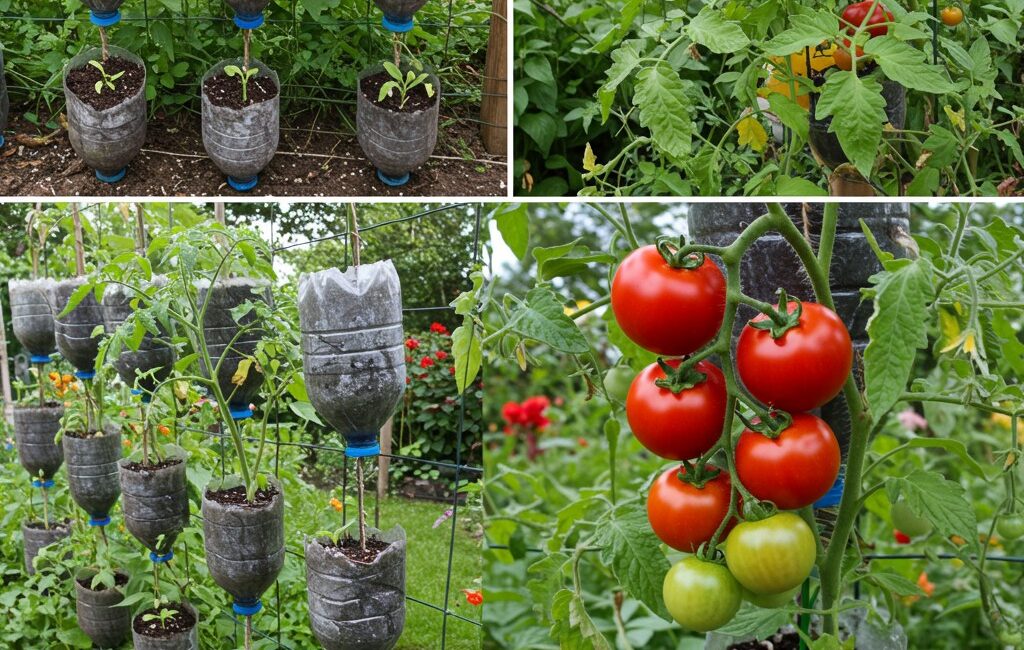Introduction: Urban Gardening Reinvented
Do you dream of harvesting fresh, juicy tomatoes but don’t have access to a traditional garden? Maybe you live in an apartment, have only a balcony, or just a sunny window ledge. Growing tomatoes without a garden is no longer a challenge thanks to creative, space-saving methods. One of the most effective and eco-friendly techniques is growing tomatoes hanging in recycled plastic bottles.
This method transforms everyday 2-liter plastic bottles into vertical hanging planters, allowing you to cultivate vibrant tomato plants without soil beds or garden plots. It’s perfect for urban gardeners, sustainability advocates, or anyone who wants to grow delicious homegrown tomatoes while reducing plastic waste.
In this comprehensive guide, you will learn everything you need to know—from the benefits of hanging bottle gardening to detailed step-by-step instructions, optimal tomato varieties, soil mixes, care tips, and troubleshooting. Whether you are a beginner or an experienced gardener, you’ll discover how to turn plastic waste into a thriving tomato oasis right on your balcony or windowsill.
Why Grow Tomatoes in Hanging Plastic Bottles?
Growing tomatoes vertically in hanging bottles offers multiple advantages over traditional gardening:
1. Space Efficiency for Urban Dwellers
With limited outdoor space, vertical gardening maximizes growing area. Hanging bottles can be fixed on walls, balconies, railings, or window grills, turning unused vertical surfaces into productive gardens.
2. Reduced Soil-Borne Diseases
Since the soil is contained and elevated, the risk of common soil-borne diseases like blight, root rot, or nematodes is significantly minimized.
3. Improved Air Circulation
Hanging plants have better airflow around leaves and stems, reducing fungal infections and encouraging healthy growth.
4. Pest Control
Elevating the plants reduces access to ground-dwelling pests such as slugs, snails, and soil insects.
5. Easy Harvesting
Hanging planters bring tomatoes to eye level, making picking ripe fruits easier without bending or stooping.
6. Eco-Friendly and Sustainable
Repurposing plastic bottles for gardening reduces plastic waste, supporting environmental sustainability and reducing gardening costs.
7. Portable and Flexible Setup
Hanging bottles are lightweight and easy to move, allowing you to adjust placement according to seasonal sun exposure or weather changes.
Materials Needed to Start Your Hanging Tomato Garden
Before you begin, gather the following materials:
- 2-liter plastic bottles (or similar size)
- Tomato seedlings (preferably dwarf, cherry, or patio varieties)
- High-quality potting mix with excellent drainage and nutrients
- Sponge, cloth, or coconut coir to plug the bottle neck and support roots
- Strong string, twine, or metal wire for hanging
- Sharp scissors or craft knife
- Watering can or spray bottle
Selecting the Best Tomato Varieties for Hanging Bottle Gardening
Not all tomato varieties are suitable for this vertical container method. The ideal tomatoes are compact, lightweight, and prolific fruit producers. Consider these varieties:
- Tiny Tim – A miniature cherry tomato, perfect for containers.
- Micro Tom – One of the smallest tomato plants, ideal for limited spaces.
- Patio Princess – Bred specifically for container growth.
- Red Robin – Compact, bushy, and heavy producer.
- Tumbling Tom – A trailing variety that cascades beautifully from hanging containers.
Choosing compact, determinate, or dwarf types prevents excessive weight and reduces the need for heavy staking.
Step-by-Step Guide: Growing Tomatoes in Hanging Plastic Bottles
Step 1: Preparing the Plastic Bottle Planter
Click page 2 for more




